Australian lace-lid
The Australian lace-lid, Day's big-eyed tree frog or lace-eyed tree frog (Ranoidea dayi) is a tree frog from Australia. It lives in northeastern Queensland.[2][3]
| Australian lace-lid | |
|---|---|

| |
| Conservation status | |
| Scientific classification | |
| Kingdom: | Animalia |
| Phylum: | Chordata |
| Class: | Amphibia |
| Order: | Anura |
| Family: | Pelodryadidae |
| Genus: | Ranoidea |
| Species: | R. dahlii
|
| Binomial name | |
| Ranoidea dahlii (Günther, 1896)
| |

| |
| Synonyms | |
| |
The adult frog is 5.0 cm long.[4] Unlike other male frogs, which can sing in groups, male Australian lace-lids are always at least 1 metre apart from each other when they sing. Scientists think that the males compete against each other for the females, that they are territorial animals.[3]
This frog lives in rainforests, especially mountain rainforests. It will eat almost anything it can catch, usually invertebrates, for example spiders and insects. Its large eyes help it hunt at night.[4]
The female frog lays eggs under rocks in streams where the water flows fast. The eggs are clear and 3.3 to 3.5 mm in diameter. The tadpoles have strong tails so they can swim in the fast water. The tadpoles eat algae on the bottom of the stream. Tadpoles that hatch early become frogs in 3-4 months. Tadpoles that hatch in the fall may stay tadpoles through the winter and become frogs the next year.[3]
Scientists are not sure why this frog is endangered. One idea is that feral pigs have come to their rainforests and rip up the low plants that the frog likes to climb on and hide in.[3] Another idea is that the fugal disease chytridiomycosis could be killing these frogs.[4]
References
- ↑ Template:Cite IUCN
- ↑ 2.0 2.1 "Ranoidea dayi (Günther, 1897)". American Museum of Natural History. Retrieved August 29, 2020.
- ↑ 3.0 3.1 3.2 3.3 J-M Hero; M. Cunningham; L. Shoo; C. Morrison; M. Stoneham (March 22, 2002). "Litoria dayi: Lace-eyed Tree Frog". AmphibiaWeb. Retrieved August 27, 2020.
- ↑ 4.0 4.1 4.2 "Cute Frog of the Week: September 5, 2011". Panama Amphibian Rescue and Conservation Project. September 5, 2011. Archived from the original on December 4, 2024. Retrieved August 29, 2020.
